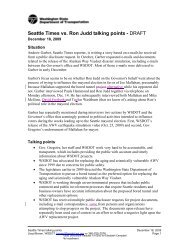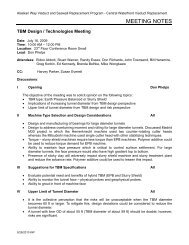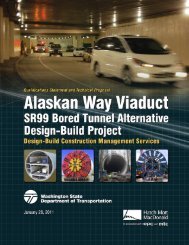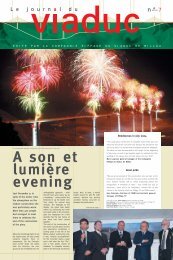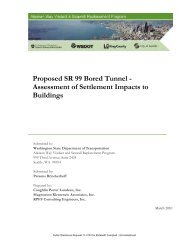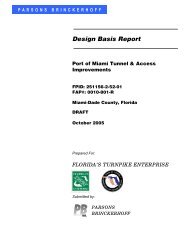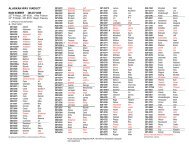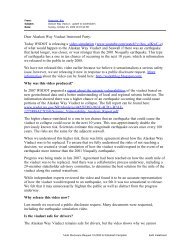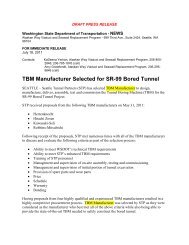Parsons - 2010 Construction Management for AWV.pdf - SCATnow
Parsons - 2010 Construction Management for AWV.pdf - SCATnow
Parsons - 2010 Construction Management for AWV.pdf - SCATnow
Create successful ePaper yourself
Turn your PDF publications into a flip-book with our unique Google optimized e-Paper software.
all aspects of ground modification. Our geotechnical team members are familiar with the anticipated soil behavior andhave facilitated ground modification programs throughout the country. As the <strong>Construction</strong> Manager in Portland <strong>for</strong> theCSO Program, Greg Colzani supervised several grouting inspectors to monitor a deep jet grouting program to protectfour bridges from tunnel-induced settlements. Our Chief inspector, Mark Bower, has inspected compensation andimpregnation grouting to minimize ground settlement and protect the existing structures in Europe and the Middle East.Assessing the risksKey Risks• Improper methods do not work as intended• Poorly installed methods result in collateral damage of ineffectivesupport• Methods not implemented in a timely mannerBored Tunnel Alternative Design-Build ProjectDesign-Build <strong>Construction</strong> <strong>Management</strong> Services SR 99As discussed above, where necessary <strong>for</strong> protection of existingstructures and utilities, ground improvements within or abovethe tunnel zone of influence can be used to limit and controlground movement due to tunnel construction. Remedial groundimprovements over the tunnel can also increase stresses on thetunnel liner. In certain cases, deep ground improvements may be usedto create a safe haven to per<strong>for</strong>m cutterhead inspections and maintenance. Care needs to be used when implementingground improvement measures to ensure that these measures do not induce heave or settlement damage to the structuresbeing protected. Table E.6 provides a representative example of our methodology, acting as CM support to WSDOT, tomanage these and similar project risks.Table E.6 Risk CM Role - Design and Pre-construction CM Role - <strong>Construction</strong>Improperly Selected or PoorlyInstalled Methods• Improper ground improvementmethods are used, which areineffective or cause damageThe CM team must confirm that the design-builder:• Reviews all plans against structure analysis and geotechnical conditions toensure proper methods are being applied• Reviews all plans and equipment to ensure that proper devices are used• Ensure plans include redundant monitoring instruments and that instrumentsare being monitored prior, during, and after workThe CM team must confirm that thedesign-builder:• Per<strong>for</strong>ms continuous inspection andmonitoring of operations to ensure that workplans are followed• Verifies the effectiveness of installationsthrough coring, testing, and other means7Deep Below Groundwater Excavation and Support of Major Structures and FacilitiesBenefits to WSDOT• Deep, below groundwater excavation shoringdesign, construction and inspection experience• In-depth understanding of project-specificgeotechnical conditions as related to shoringdesign• Experts in local geologyTony Stirbys managed the instrumentationmonitoring program and Alf Evers wasthe Senior Inspector <strong>for</strong> the excavation onthe Alameda Corridor project involving theconstruction of a shored structure that required4 million cubic yards of excavation, 950,000cubic yards of concrete, and 170 million poundsof rein<strong>for</strong>cing steel.Our CM team is well-versed in all construction methods involving deep excavation below groundwater. Steve Minassianhas designed and constructed deep shafts and excavation as a contractor’s engineer, including the freeze wall in Providence,RI. Greg Colzani has acted as the <strong>Construction</strong> Manager and Resident Engineer <strong>for</strong> conventionally shored excavations,secant pile walls, cutter soil mix walls, ground freeze operations, and slurry walls. In Portland, he was the <strong>Construction</strong>Manager <strong>for</strong> the 120-foot deep pump station slurry wall shaft. The pump station required slurry walls 200 feet deep anda 320-foot deep, jet-grouted water cut off. Tony Stirbys and Alf Evers have extensive deep excavation monitoring andshoring experience including the Alameda Corridor project. Our local knowledge of the geology and surface constraintsare an added value.41




